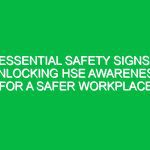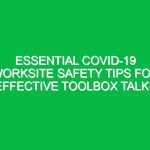Welcome to Our Toolbox Talk
Hello, team! Thank you for gathering here today for our Toolbox Talk. The purpose of this discussion is to highlight an essential topic that affects our health and Safety—COVID-19 Symptoms. As we continue working through these challenging times, it’s crucial for each of us to understand these symptoms, how to recognize them, and the steps we should take to maintain a safe working Environment. Let’s dive in!
Understanding COVID-19 Symptoms
COVID-19 is caused by the coronavirus SARS-CoV-2, and its symptoms can vary widely from mild to severe. Recognizing these symptoms early can help prevent the spread of the virus within our workplace and protect our colleagues and families. Here are the most common COVID-19 Symptoms:
- Fever or chills: A temperature above 100.4°F (38°C) is a significant sign that your body is fighting an infection.
- Cough: A persistent dry cough can indicate a respiratory issue, potentially linked to COVID-19.
- Shortness of breath: Difficulty breathing or feeling winded during activities can be a serious symptom.
- Fatigue: Unusual tiredness or lethargy that doesn’t improve with rest can be a warning sign.
- Muscle or body aches: Generalized pain or discomfort should not be overlooked.
- Headache: A sudden headache that is different from your norm may suggest illness.
- New loss of taste or smell: This symptom has become one of the hallmarks of COVID-19 and is often a precursor to more severe symptoms.
- Sore throat: This can be confused with allergies or a cold but should be monitored.
- Congestion or runny nose: Although common, if it appears suddenly with other symptoms, it requires attention.
- Nausea or vomiting: Digestive issues can also be part of the spectrum of COVID-19 Symptoms.
- Diarrhea: Gastrointestinal symptoms should not be dismissed, especially if they are accompanied by others.
Why Recognizing COVID-19 Symptoms Is Crucial
Understanding COVID-19 Symptoms is vital for several reasons:
- Preventing Spread: Identifying symptoms early allows for immediate action, which can prevent further transmission within the workplace.
- Protecting Vulnerable Individuals: Many individuals may be at higher risk for severe illness, including older adults and those with underlying health conditions.
- Maintaining Operational Continuity: By reducing the potential spread of the virus, we can ensure that operations continue smoothly without significant disruptions.
Potential Hazards and Risks Related to COVID-19 Symptoms
COVID-19 Symptoms pose several Hazards and risks in the workplace. It is crucial to consider these when assessing our health and Safety practices:
- Transmission Risk: Close contact with an infected person can lead to the virus spreading rapidly.
- Workplace Disruption: Outbreaks can lead to staff shortages and operational delays.
- Panic and Anxiety: Employees may feel anxious about their health and the health of their colleagues, affecting morale and productivity.
Best Practices for Identifying COVID-19 Symptoms
Here are some Best Practices that you can implement to recognize and respond to COVID-19 Symptoms effectively:
- Daily Health Checks: Encourage everyone to perform self-assessments before coming to work. This can be as simple as asking if you feel unwell or have any of the symptoms listed above.
- Temperature Screening: If feasible, implement temperature checks at entry points to identify employees who may have a fever.
- Promote Open Communication: Foster an environment where employees feel comfortable reporting symptoms without fear of repercussions.
- Stay Informed: Regularly review updates from health authorities about COVID-19 Symptoms and guidelines.
What to Do If You Experience COVID-19 Symptoms
If you or someone you know develops symptoms of COVID-19, follow these steps:
- Stay Home: If you feel unwell or exhibit any COVID-19 Symptoms, do not come to work. This is crucial to prevent spreading the virus.
- Self-Isolate: Keep yourself isolated from others to reduce the chance of transmission.
- Seek Medical Advice: Contact your healthcare provider for guidance on testing and next steps.
- Notify Management: Inform your supervisor about your symptoms so they can take the necessary Precautions.
- Follow Protocols: Adhere to any company policies regarding illness and COVID-19 exposure.
Real-Life Examples and Scenarios
Let’s consider a couple of hypothetical scenarios to emphasize the importance of recognizing COVID-19 Symptoms:
Scenario 1: John comes to work feeling fatigued and has a slight cough. He brushes it off as allergies. After a few days, he develops a fever and tests positive for COVID-19. Because he ignored his symptoms and continued to work, he unknowingly exposed several colleagues, leading to multiple infections in the office.
Scenario 2: Sarah develops a sudden loss of taste. Instead of waiting to see if it improves, she promptly informs her supervisor and gets tested. She tests positive but was able to isolate quickly before coming into contact with others, preventing an outbreak.
These scenarios highlight the importance of recognizing and acting on COVID-19 Symptoms. By being vigilant and proactive, we can protect ourselves and our coworkers.
Regulations and Standards Related to COVID-19 Symptoms
It is essential to be aware of Regulations and standards that govern Workplace Health and safety related to COVID-19:
- OSHA Guidelines: The Occupational Safety and Health Administration (osha) provides regulations that require employers to implement Safety Measures to protect workers from COVID-19.
- CDC Recommendations: The Centers for Disease Control and Prevention (CDC) offers guidance on recognizing symptoms and protocols to follow.
- Company Policies: Familiarize yourself with your company’s specific policies regarding COVID-19 Symptoms, reporting, and response strategies.
Compliance with these regulations not only protects employees but also fulfills legal obligations and minimizes liability for the organization.
Conclusion: Your Role in Maintaining a Safe Workplace
In summary, understanding COVID-19 Symptoms is crucial in our ongoing efforts to maintain a safe working environment. By recognizing these symptoms early, adhering to Best Practices, and following established protocols, we can collectively protect ourselves and our community.
Please remember that your health is paramount. If you experience any symptoms, take immediate action. Thank you for your attention and commitment to safety. Let’s continue working together to ensure a healthy workplace for everyone!


